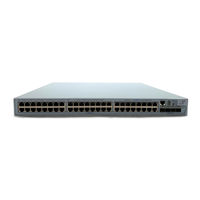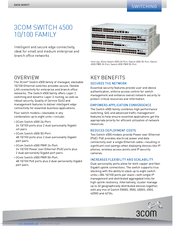3Com 4500 PWR Manuals
Manuals and User Guides for 3Com 4500 PWR. We have 6 3Com 4500 PWR manuals available for free PDF download: Configuration Manual, Getting Started Manual, Datasheet
3Com 4500 PWR Configuration Manual (742 pages)
26/50-Port
Table of Contents
-
-
Login6
-
-
Introduction11
-
-
-
Introduction23
-
-
-
CLI Views42
-
CLI Features45
-
Online Help45
-
Command Edit48
-
-
Introduction49
-
User Control56
-
Introduction56
-
-
-
-
-
-
-
-
-
Overview121
-
Port Isolation132
-
-
-
Introduction137
-
-
Dldp
148-
Overview149
-
-
DLDP Packets150
-
DLDP Status152
-
DLDP Timers152
-
-
-
Overview162
-
-
Mstp
177-
Overview179
-
-
Enabling MSTP206
-
-
Enabling MSTP211
-
-
Introduction216
-
-
-
-
-
-
IP Route227
-
Routing Table227
-
Multicast229
-
-
-
-
RIP Overview236
-
-
-
-
-
Multicast Models262
-
-
-
-
-
-
Troubleshooting322
-
-
-
-
1 Aaa Overview
329 -
-
-
-
Related Concepts364
-
-
Configuring ARP376
-
-
1 DHCP Overview
380 -
-
-
-
-
ACL Overview407
-
Mirroring
423-
Overview424
-
-
Priority Marking431
-
Traffic Policing431
-
Line Rate432
-
VLAN Mapping432
-
Queue Scheduling432
-
-
Configuring WRED444
-
-
-
-
Cluster
476-
Cluster477
-
Cluster Overview477
-
-
-
-
Poe Overview507
-
-
-
-
SNMP Overview525
-
SNMP Versions525
-
Supported Mibs526
-
Displaying SNMP530
-
-
-
-
-
SSH Overview562
-
-
-
-
-
Advertisement
3Com 4500 PWR Getting Started Manual (88 pages)
Switch 4500 Family 26/50-Port
Table of Contents
-
-
In Outs
59
3Com 4500 PWR Datasheet (16 pages)
SWITCH 4500 10/100 FAMILY
Advertisement
3Com 4500 PWR Datasheet (8 pages)
SWITCH 4500 10/100 FAMILY
Advertisement





